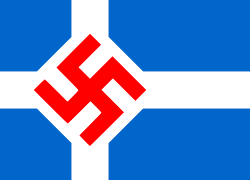Nationalist Party (Iceland)
 From Wikipedia - Reading time: 17 min
From Wikipedia - Reading time: 17 min
Nationalist Party | |
|---|---|
| Party leader | Jón H. Þorbergsson |
| Party leader | Eiður S. Kvaran |
| Party leader | Gísli Sigurbjörnsson |
| Founded | 1934 |
| Dissolved | 1944 |
| Headquarters | Reykjavík |
| Newspaper | Ísland Mjölnir |
| Membership | 450 |
| Ideology | Corporate statism Icelandic nationalism Antisemitism Industrialism Militarism Anti-communism |
| Political position | Far-right |
| Party flag | |
 | |

The Nationalist Party (Icelandic: Flokkur Þjóðernissinna) was a minor Icelandic political party that espoused a limited form of fascism before and during the Second World War.
History
[edit]The party was formed in March 1934 through a merger between the Icelandic Nationalist Movement (an anti-communist and anti-democratic ginger group) and the Icelandic Nationalist Party (a politicized splinter group of the former formed in 1933).[1] The Nationalist Movement was loosely linked to the Independence Party and when the Nationalist Party was established many of its more conservative-minded adherents refused to join the new party.[2] This initial departure of the more moderate tendency ensured that the Nationalist Party proved more radical and extremist than either of its predecessor groups.[2] The party aimed to protect the ethnic identity of the Icelanders and believed in the supremacy of the Aryan race and anti-Semitism.[2] They supported agricultural reform and were sympathetic to corporatism, whilst looking for the government to invest in industrialization.[3] They also sought to abolish the Althing and replace it with a corporate parliament.[3] The party also rejected the left-right dichotomy and presented themselves as a radical alternative for Icelandic politics.[3] In all, they were more influenced by the ideas of Frits Clausen than those of Adolf Hitler[3] and there is no evidence to suggest any direct link to Nazi Germany.[4]
Adopting some of the militaristic trappings of fascism, the party organised a number of marching squads which paraded on May 1 carrying both the Icelandic flag and the swastika.[5] Members dressed in grey shirts and wore armbands decorated with a red swastika.[5] The party produced a newspaper Ísland (Iceland) and a periodical Mjölnir (named after Thor's hammer), although they did not adopt the führerprinzip associated with Nazism as the movement had four different leaders in its brief life.[5]
The Nationalist Party failed to gain representation, except on the University of Iceland Student Council, where they held one seat for four years running.[6] They did, however, gain attention in 1936 when they obtained a copy of the diary of the Minister of Finance and published details in Ísland.[5] The party offices were raided by police and a number of leading members arrested, although ultimately there were no convictions.[5] In general, however, they did not enjoy widespread support at any point in their existence, despite wide admiration for Nazi Germany in the island.[7] This was reflected in their electoral performances, with the party gaining 0.7% of the vote in the 1934 election and 0.2% in 1937.[2] Their best result was 2.8% in the 1934 municipal elections in Reykjavik.
The party, which never had more than 450 members, began to decline after the arrests.[4] The marching squads appeared for the last time in 1938, whilst the 1939 Aims of the Nationalist Party was their last major publication, apart from sporadic issues of Island.[4] They organised a debating club in Reykjavík during the winter of 1939-1940 although it had no impact and the party generally only met in local cells from then on.[4] Following the invasion of Iceland in 1940 the group was largely suppressed by the occupying Allies.[2] The party was formally disbanded in 1944 when German defeat looked inevitable.[4]
Election results
[edit]| Election | Votes | % | Seats | +/– | Position | Government |
|---|---|---|---|---|---|---|
| 1934 | 363 | 0.70 | 0 / 49
|
Opposition | ||
| 1937 | 118 | 0.20 | 0 / 49
|
Opposition |
References
[edit]Bibliography
[edit]- Ásgeir Guðmundsson, "Nazism in Iceland", S. U. Larsen, B. Hagtvet & J. P. Myklebust, Who Were the Fascists: Social Roots of European Fascism, Scandinavian University Press, Oslo, 1980. ISBN 82-00-05331-8
Footnotes
[edit]- ^ Gundmundsson, p. 745
- ^ a b c d e Valur Ingimundarson, "Iceland" in Cyprian Blamires, Paul Jackson (eds.), World Fascism: A Historical Encyclopedia, Volume 1, ABC-CLIO, 2006, p. 329
- ^ a b c d Gudmundsson, p. 746
- ^ a b c d e Gudmundsson, p. 749
- ^ a b c d e Gudmundsson, p. 747
- ^ Gudmundsson, p. 748
- ^ Gudni Thorlacius Johannesson, The History of Iceland, ABC-CLIO, 2013, p. 89
 KSF
KSF